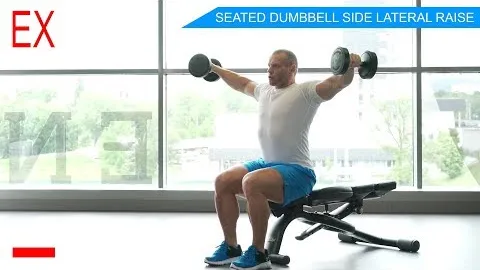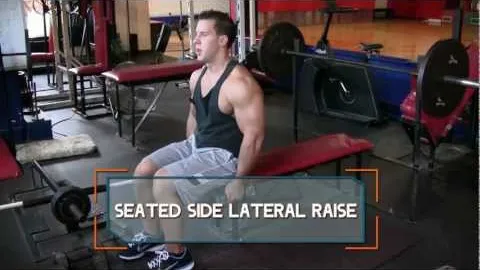


Are you looking to build strong and well-defined shoulders? If so, incorporating the seated dumbbell side lateral raise exercise into your workout routine is a must! This exercise is highly effective in targeting the side deltoids, also known as the lateral delts, which play a crucial role in creating a wider and more well-rounded shoulder appearance.
The seated dumbbell side lateral raise offers numerous benefits when it comes to shoulder training. Here's why you should make it a staple in your workout routine:
Targeted Muscle Activation: This exercise primarily targets the side deltoids, helping to isolate and strengthen this specific area of the shoulder. By focusing on the lateral delts, you can achieve a more balanced and aesthetically pleasing shoulder development.
Improved Shoulder Stability: Seated dumbbell side lateral raises also engage the muscles that provide support and stability to the shoulder joint. Strengthening these muscles can help prevent injuries and enhance overall shoulder function.
Added Versatility: The exercise can be easily modified to accommodate individuals of various fitness levels. Whether you're a beginner or an advanced lifter, you can adjust the weight and intensity to suit your needs.
Increased Range of Motion: Performing seated dumbbell side lateral raises forces your shoulder joint to move through a full range of motion. This motion helps to improve flexibility and mobility, resulting in better overall shoulder health.
Now that we understand why seated dumbbell side lateral raises are an essential exercise for shoulder training, let's dive into the proper technique and form.
Follow these step-by-step instructions to master the seated dumbbell side lateral raise:
Preparation: Sit on a weight bench with your back straight and core engaged. Hold a dumbbell in each hand, palms facing your body. Place your feet firmly on the ground, slightly wider than shoulder-width apart.
Starting Position: Position your arms along the sides of your body, elbows slightly bent, and maintain a slight bend in your knees.
Execution: Begin the movement by simultaneously lifting both dumbbells to your sides. Keep your palms facing down throughout the entire motion. Avoid swinging or using excessive momentum to lift the weights. Ensure that your elbows are slightly higher than your wrists at the top of the motion.
Top Position: Pause for a brief moment when your arms are parallel to the ground. Focus on squeezing your lateral deltoids to maximize muscle activation.
Return: Gradually lower the dumbbells back to the starting position, maintaining control throughout the descent. Remember to avoid swinging or dropping the weights too quickly.
To ensure you perform seated dumbbell side lateral raises correctly and safely, here are a few key tips to keep in mind:
Maintain Proper Posture: Sit with your back straight and core engaged throughout the exercise. Avoid slouching or rounding your shoulders, as this can lead to poor form and potential injuries.
Control the Weights: Focus on controlled movements throughout the entire range of motion. Avoid using momentum or swinging your arms to lift the weights. Instead, use the muscles in your shoulders to perform the exercise.
Prime the Deltoids: Prioritize engaging your lateral deltoids during the movement. Visualize lifting the weights with your shoulders, rather than relying solely on your arms.
Choose Appropriate Weight: Start with light to moderate dumbbells and gradually increase the load as you gain strength and improve your form. Using excessively heavy weights can compromise your form and increase the risk of injury.
Now that you understand the correct form and technique for seated dumbbell side lateral raises, it's crucial to know how to incorporate them into your workout routine effectively. Here are a few suggestions:
Warm-Up: Begin your shoulder workout with a dynamic warm-up routine to activate the muscles and prepare them for exercise. This can include arm circles, shoulder rotations, and gentle stretches.
Exercise Placement: Include seated dumbbell side lateral raises after compound exercises like overhead presses or upright rows. This allows you to target the lateral delts when they are fresh rather than fatigued.
Sets and Repetitions: Aim for 3-4 sets of 8-12 repetitions per set. Adjust the weight accordingly to challenge your muscles while maintaining proper form.
Progressive Overload: To continually stimulate muscle growth and strength gains, progressively increase the weight or repetitions over time. This principle of progressive overload helps to prevent plateaus and ensures continuous progress.
Incorporating seated dumbbell side lateral raises into your shoulder workout routine is an excellent strategy for building well-defined and strong deltoids. By targeting the side deltoids specifically, this exercise can enhance your overall shoulder aesthetics and functional strength.
Remember to prioritize proper form and technique to maximize your results and minimize the risk of injury. By incorporating this exercise into your routine and following these guidelines, you'll be well on your way to achieving the shoulder development you desire.
Now, grab those dumbbells, find a comfortable seat, and start performing seated dumbbell side lateral raises for stronger, more sculpted shoulders!
If you're looking for a gym, fitness club or yoga studio, you've come to the right place.
You can find information about gyms in your area. Browse catalog of gyms and find gyms with classes which are you looking for.
On gym page you can find simple information like address, phone or website. You can find list of available classes. You can check availability of personal training or small group classes. On place page you can also see information about open hours.
You can find gyms near you with amenities, courts, studios and equipments.
Use our map to find gym at your city or district.
In Gym Navigator you can find list of exercises with movies for many body parts.
You can browse exercises catalog and find exercises the best of you.
You can also find exercises grouped into workout plans, which you can use to improve you body. Each routine show you exercises one by one and give you possibility to count you progress and count down rest time.